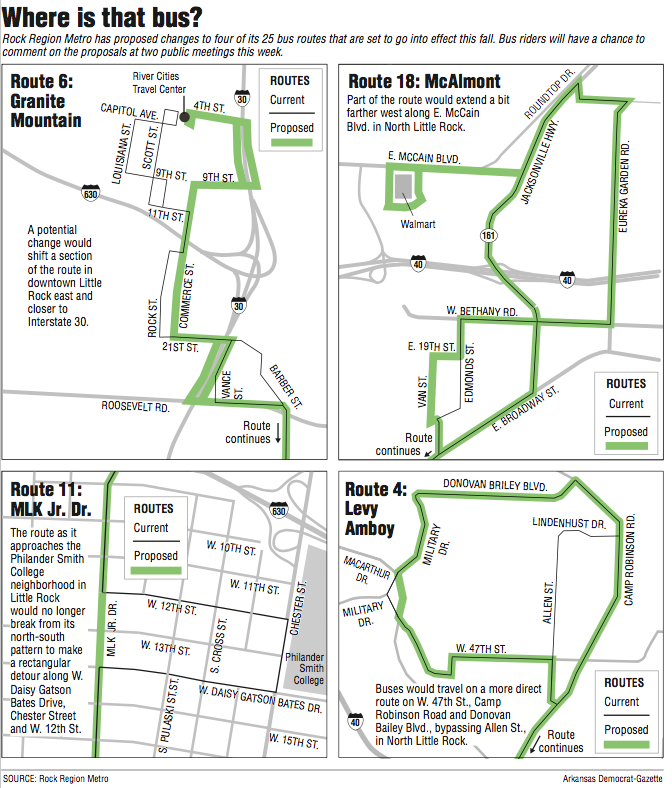The old is new again on two Rock Region Metro bus routes.
Two recently modified routes -- one in Little Rock and one in North Little Rock -- would return to their old alignment under the latest proposed changes to the Pulaski County transit agency's main bus service.
Rock Region also proposes changes to two other routes on either side of the Arkansas River.
The proposals grew out of an annual review gauging the effectiveness of the system's 25 main bus routes and looking for ways to improve service at little or no cost. This is the third year Rock Region has undertaken what it calls "annual service enhancements."
The annual review is Plan B after an initiative to dedicate a one-fourth percentage-point increase in the county sales tax to transit was rejected by voters in the March 2016 primary.
Had the tax passed, the agency would have expanded regular bus service and put in limited bus rapid transit routes on high-traffic corridors in Little Rock. Bus rapid transit features larger buses with platform stops and has some portion of the roadway dedicated to the buses.
The two routes returning to the configurations they had two years ago are Route 11, which serves an area that includes Dr. Martin Luther King Jr. Drive, and Route 18, which serves an area that includes the community of McAlmont. But the transit agency also is extending Route 18.
Route 11 was modified two years ago to serve Philander Smith College on Chester Street, but Donna Bowers, Rock Region's operations director, said the route change "attracted little ridership from the college."
Little Rock City Manager Bruce Moore, a member of the Rock Region board of directors, said at a briefing on the changes last week he would prefer to see the service to Philander Smith via Chester remain in place for now.
He noted that the changes are being proposed when the staff said it will be reaching out to Philander Smith and Arkansas Baptist College to explore possible fare agreements.
The University of Arkansas-Pulaski Technical College, the University of Arkansas at Little Rock and the Little Rock School District already participate in the Universal Pass Program.
UALR, for instance, pays $28,000 annually in exchange for allowing its students and staff to ride the agency's buses. It is set to renew the annual agreement next month. The staff estimates the first agreement, reached in August 2017, will have generated 40,000 rides by the time it expires this month.
The board last week approved a fare agreement for Shorter College in North Little Rock in which the institution of higher learning will pay $1,200 annually.
Charles Frazier, the agency's executive director, told the board he would reach out to Philander Smith College before the next board meeting.
Route 18 was modified to improve "on-time performance," Bowers said. "The results have been a wash."
As a result, she said, the agency recommends returning Ben Street and 19th Street in a small neighborhood off East Broadway in North Little Rock to the route. Two years ago, Rock Region had bypassed the two streets.
The agency also proposed extending the route to a Walmart store on East McCain Boulevard. That extension was made possible by the opening of a $10.17 million railroad overpass on McCain in December, Bowers said.
By extending Route 18 to the Walmart, it would allow cross-town access for riders in North Little Rock because the agency's busiest route in North Little Rock, Route 10, also stops at the Walmart, according to Bowers.
"This creates a huge impact," she told the Rock Region board.
The downside, Bowers said, is that stop frequency would increase from 45 minutes to 50 minutes.
The other proposed changes include service on Route 4, which serves the Levy and Amboy areas of North Little Rock, and Route 6, which serves the Granite Mountain area in east Little Rock.
Route 4 has two patterns, one called the peak pattern, which reaches the Amboy neighborhood via Donovan Briley Boulevard, and an off-peak pattern limited to Levy.
"We proposed to run the route exclusively along the path of the peak pattern, thereby increasing off-peak access to residents of the Amboy area, as well as recently built apartment complexes along Donovan Briley," Bowers said.
The agency proposes "moderate" changes to Route 6, including shifting the downtown portion of its route east to the Interstate 30 access roads, which will add service to the hotels located there as well as the Arkansas Arts Center, Bowers said.
The other change involves moving a section of the route to I-30 near Roosevelt Road, which would provide service to Our House. The nearest stop now for the shelter for homeless families is a distance of three blocks. The change also would create a longer two-way route on Roosevelt, Bowers said.
All four will be the subject of two public meetings to solicit comment on the proposed changes.
The first meeting will be held from 11:30 a.m. to 1 p.m. Monday at the main branch of the Central Arkansas Library System at 100 S. Rock St., Little Rock.
The second will be held during the same hours Tuesday at North Little Rock City Hall at 300 Main St. in North Little Rock.
The agency has found that attendance has been greater at public meetings held "in the middle of the day" than at public meetings held in the evenings, according to Bowers.
Metro on 07/29/2018
CORRECTION: Proposed changes to Route 6, a bus route serving Rock Region Metro riders in the Granite Mountain area of Little Rock, partly involves shifting part of the route east from downtown to the Interstate 30 access roads. A previous version of this article referred to a different route.

